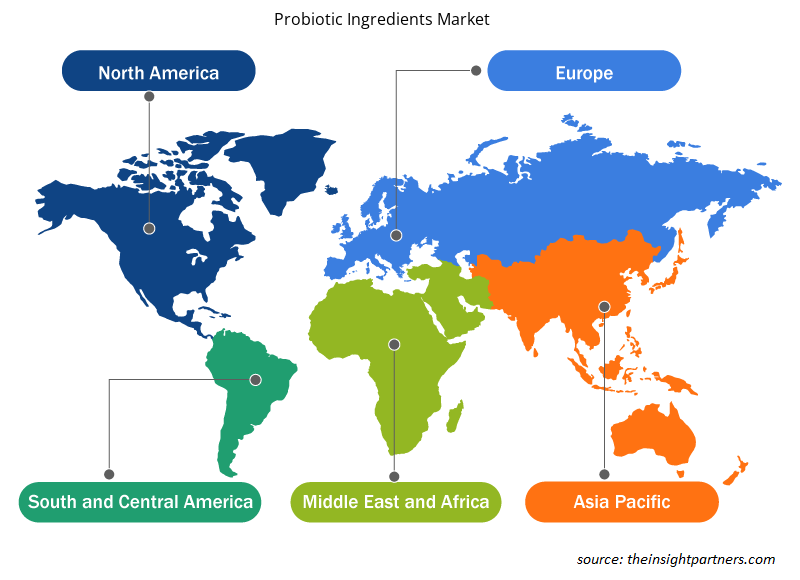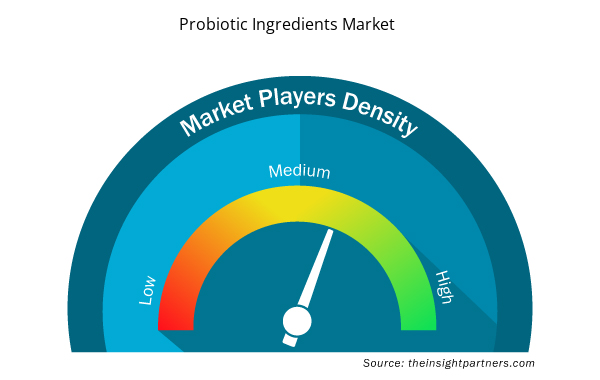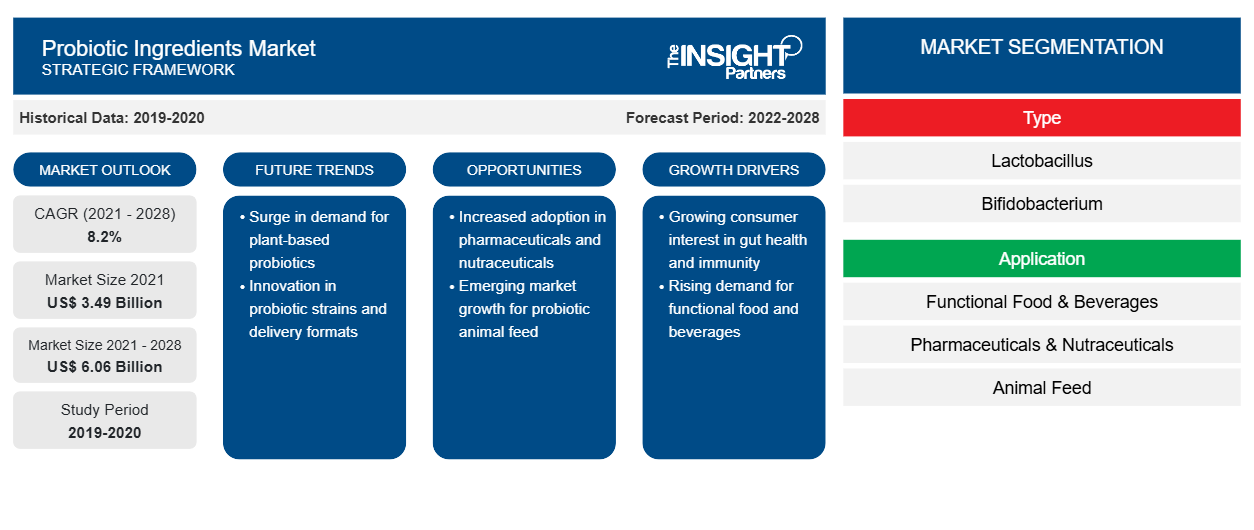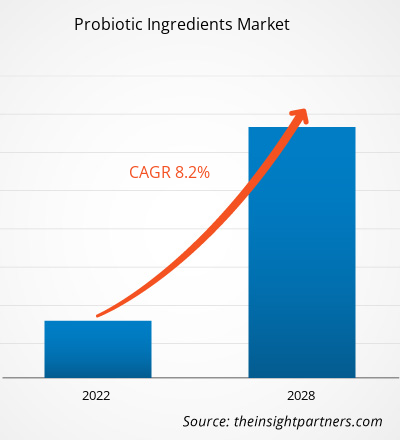프로바이오틱스 성분 시장은 2021년 34억 9,342만 달러에서 2028년 60억 6,051만 달러로 성장할 것으로 예상되며, 2022년에서 2028년까지 연평균 성장률 8.2%로 성장할 것으로 예상됩니다.
프로바이오틱스는 섭취 시 건강상의 이점을 제공하는 살아있는 미생물로, 일반적으로 장내세균총을 개선하거나 회복시켜줍니다. 프로바이오틱스는 일반적으로 섭취하기에 안전한 것으로 간주됩니다. 프로바이오틱스는 면역 체계를 강화하여 질병 발생을 예방하기 때문에 예방 건강 관리에서 중요한 역할을 합니다. 따라서 예방 건강 관리에 대한 인식이 높아지면 예측 기간 동안 시장 성장이 촉진될 것으로 예상됩니다.
아시아 태평양 지역은 2021년에 가장 큰 프로바이오틱스 성분 시장 점유율을 차지한 반면, 중동 및 아프리카와 같은 다른 개발 도상국은 예측 기간 동안 상당히 성장할 것으로 예상됩니다. 시장 성장은 마실 수 있는 프로바이오틱스 요거트 및 플레인 요거트와 같은 기능성 식품 및 음료에 대한 수요 증가와 이 지역의 젊은 인구에 대한 서구 문화의 영향력 증가에 기인합니다. 게다가, 프로바이오틱스 제조업체는 잠재적인 고객 기반, 저렴한 노동력 및 적절한 제조 시설이 존재하기 때문에 아시아 태평양 전역에서 사업을 확장하고 있습니다. Probi 및 Bio-k+(Kerry)와 같은 회사는 이 지역에서 활발하게 운영되고 있으며, 이는 향후 몇 년 동안 아시아 태평양 프로바이오틱스 성분 시장을 주도할 것으로 예상됩니다.
귀하의 요구 사항에 맞게 이 보고서를 사용자 정의하세요
이 보고서의 일부 또는 국가 수준 분석, Excel 데이터 팩을 포함하여 모든 보고서에 대한 사용자 정의를 무료로 받을 수 있으며 신생 기업 및 대학을 위한 훌륭한 혜택과 할인 혜택을 이용할 수 있습니다.
- 이 보고서의 주요 시장 동향을 알아보세요.이 무료 샘플에는 시장 동향부터 추정 및 예측까지 다양한 데이터 분석이 포함됩니다.
COVID-19 팬데믹이 프로바이오틱스 성분 시장에 미치는 영향
COVID-19 팬데믹은 2020년 초 많은 분야에 전례 없는 어려움을 가져왔습니다. WHO와 국가 보건부의 지침에 따라 정부가 시행한 봉쇄, 국경 제한, 여행 금지, 제조 중단 및 기타 안전 조치로 인해 제조 운영이 방해를 받았습니다. 그러나 COVID-19 발병은 소비자들이 건강을 유지하고 면역 체계를 강화하기 위해 점점 더 자연스럽고 안전한 대안을 찾고 있기 때문에 시장에 긍정적인 영향을 미쳤습니다. 팬데믹 초기 몇 달 동안 건강 보충제 에 대한 수요가 극적으로 증가했습니다. 게다가 사람들이 정부 명령으로 집에 머물면서 건강과 피트니스에 집중했고, 이는 팬데믹 동안 프로바이오틱스에 대한 수요를 자극했습니다.
시장 통찰력
프로바이오틱 강화 식품 및 음료에 대한 수요 증가
소비자들은 건강을 더 의식하고 라이프스타일과 식단에 더 많은 관심을 기울이고 있으며, 그 결과 전 세계적으로 프로바이오틱 강화 식품과 음료에 대한 수요가 급증하고 있습니다. 소비자 수요에 부응하기 위해 식품 제조업체는 현재의 건강한 식생활 트렌드에 대응하여 설명서와 그림이 있는 다양한 신제품을 개발하고 있습니다. 예를 들어, 일본 기업인 야쿠르트 혼샤는 1955년에 프로바이오틱 유제품 음료를 출시했지만, 여러 업계 전문가가 이를 무시했습니다. 그러나 현재는 아시아 태평양, 유럽, 북미에서 발견되는 세계 최대의 프로바이오틱 유제품 브랜드로 시장 성장을 주도하고 있습니다.
유형 기반 통찰력
유형에 따라 프로바이오틱스 성분 시장은 Lactobacillus, Bifidobacterium 및 Others로 세분화됩니다. Lactobacillus 세그먼트는 예측 기간 동안 가장 큰 점유율을 기록할 것으로 예상됩니다. 프로바이오틱스로 사용하기에 가장 안전한 박테리아 중 하나로 간주됩니다. Lactobacillus는 케피어, 자우어크라우트 및 요구르트와 같은 발효 식품에 주로 적용되는 박테리아 유형입니다. Lactobacillus 균주는 인간의 장 질환을 줄일 수 있기 때문에 사람들에게 도움이 되며, 이는 수요를 증가시킬 것으로 예상됩니다. Lactobacillus 세그먼트의 성장은 특히 유제품에서 프로바이오틱스의 식품 적용 증가로 인해 시장 성장을 촉진합니다.
애플리케이션 기반 통찰력
응용 프로그램을 기준으로, 프로바이오틱 성분 시장은 기능성 식품 및 음료, 의약품 및 건강기능식품, 동물 사료 및 기타로 세분화됩니다. 의약품 및 건강기능식품 세그먼트는 예측 기간 동안 시장에서 가장 높은 CAGR을 기록할 것으로 예상됩니다. 예방 의약품에 대한 수요 증가, 노인의 소화기 질환 증가, 균형 잡힌 식단 부족으로 인해 식이 보충제 산업에서 제품 수요가 증가할 가능성이 높습니다. 소비자는 건강에 해로운 식단의 채택이 증가함에 따라 프로바이오틱 기반 식품 보충제를 점점 더 선호합니다.
프로바이오틱 성분 시장에서 활동하는 주요 기업은 ADM, Novozymes A/S, Chr. Hansen Holding A/S, Kerry, Lallemand Inc., IFF Nutrition & Biosciences, AngelYeast Co., Ltd., Probiotical SpA, Adisseo, Probi입니다. 이러한 기업은 새로운 소비자 트렌드를 충족하고 규제 프레임워크를 준수하기 위해 건강 위험이 낮은 제품을 개발하는 데 참여하고 있습니다. 이들은 시장 점유율을 확대하기 위해 합병 및 인수, 사업 확장 및 파트너십에 참여하고 있습니다.
프로바이오틱 성분 시장 지역 통찰력
Insight Partners의 분석가들은 예측 기간 동안 프로바이오틱 성분 시장에 영향을 미치는 지역적 추세와 요인을 철저히 설명했습니다. 이 섹션에서는 북미, 유럽, 아시아 태평양, 중동 및 아프리카, 남미 및 중미의 프로바이오틱 성분 시장 세그먼트와 지리에 대해서도 설명합니다.

- 프로바이오틱 성분 시장에 대한 지역별 데이터 얻기
프로바이오틱 성분 시장 보고서 범위
| 보고서 속성 | 세부 |
|---|---|
| 2021년 시장 규모 | 34억 9천만 달러 |
| 2028년까지 시장 규모 | 60억 6천만 달러 |
| 글로벌 CAGR (2021-2028) | 8.2% |
| 역사적 데이터 | 2019-2020 |
| 예측 기간 | 2022-2028 |
| 다루는 세그먼트 | 유형별로
|
| 포함된 지역 및 국가 | 북아메리카
|
| 시장 선도 기업 및 주요 회사 프로필 |
|
프로바이오틱 성분 시장 참여자 밀도: 비즈니스 역학에 미치는 영향 이해
프로바이오틱스 성분 시장 시장은 소비자 선호도의 변화, 기술 발전, 제품의 이점에 대한 인식 증가와 같은 요인으로 인해 최종 사용자 수요가 증가함에 따라 빠르게 성장하고 있습니다. 수요가 증가함에 따라 기업은 제품을 확장하고, 소비자의 요구를 충족하기 위해 혁신하고, 새로운 트렌드를 활용하여 시장 성장을 더욱 촉진하고 있습니다.
시장 참여자 밀도는 특정 시장이나 산업 내에서 운영되는 회사나 기업의 분포를 말합니다. 주어진 시장 공간에 얼마나 많은 경쟁자(시장 참여자)가 존재하는지 그 규모나 전체 시장 가치에 비해 나타냅니다.
프로바이오틱스 성분 시장에서 활동하는 주요 기업은 다음과 같습니다.
- 영어: ADM(영어)
- 노보자임스 A/S
- Chr. Hansen Holding A/S
- 케리 그룹 유한회사
- 랄레만드 주식회사
면책 조항 : 위에 나열된 회사는 어떤 특별한 순서에 따라 순위가 매겨지지 않았습니다.

- 프로바이오틱 성분 시장 주요 주요 업체 개요를 알아보세요
스포트라이트 보고서
- 프로바이오틱스 성분 시장의 진보적인 산업 동향은 플레이어가 효과적인 장기 전략을 개발하는 데 도움이 됩니다.
- 선진 및 개발도상 시장에서 성장을 확보하기 위해 채택된 사업 성장 전략
- 2022년부터 2028년까지 프로바이오틱스 성분 시장의 정량적 분석
- 프로바이오틱스에 대한 세계적 수요 추산
- 산업에서 운영되는 구매자와 공급자의 효율성을 설명하기 위한 포터의 5가지 힘 분석
- 경쟁 시장 시나리오를 이해하기 위한 최근 개발
- 시장 동향 및 전망, 그리고 프로바이오틱스 성분 시장 성장을 지배하는 요인들
- 상업적 관심을 뒷받침하는 시장 전략을 강조하여 의사 결정 프로세스를 지원하고 시장 성장을 이끕니다.
- 다양한 노드에서의 프로바이오틱스 성분 시장 규모
- 시장과 프로바이오틱스 산업 역학에 대한 자세한 개요 및 세분화
- 유망한 성장 기회가 있는 다양한 지역의 성장 규모
- 역사적 분석(2년), 기준 연도, CAGR을 포함한 예측(7년)
- PEST 및 SWOT 분석
- 시장 규모 가치/양 - 글로벌, 지역, 국가
- 산업 및 경쟁 환경
- Excel 데이터 세트



Report Coverage
Revenue forecast, Company Analysis, Industry landscape, Growth factors, and Trends

Segment Covered
This text is related
to segments covered.

Regional Scope
North America, Europe, Asia Pacific, Middle East & Africa, South & Central America

Country Scope
This text is related
to country scope.
자주 묻는 질문
The increasing consumer focus in preventive health driving global probiotic ingredients market. Over the past few years, the awareness regarding health and nutrition has increased significantly. Because of hectic work schedules and extended working hours, people cannot concentrate on their daily diet, health, and fitness, thereby leading to various health issues such as obesity, diabetes, and digestive problems. Therefore, people increasingly focus on preventive health and prefer dietary supplements that offer enhanced health benefits without harmful effects. Thus, people are getting more aware of digestive health and prefer to consume probiotics. These dietary supplements improve digestion and nutrient absorption. Thus, the rising consumers focus on preventive health the demand for probiotic-infused dietary supplements that offer nutritional benefits also increased and is further driving the growth of the probiotic ingredients market.
Based on the application, pharmaceuticals and nutraceuticals segment is projected to grow at the fastest CAGR over the forecast period. Probiotic ingredients have demonstrated their high potential to treat various diseases, including neurodegenerative disorders, cancers, cardiovascular diseases, and inflammatory diseases. Probiotic ingredients are also effective against multidrug-resistant pathogens and help maintain a balanced gut microbiota ecosystem. The rising demand for preventive medicines, an increased number of digestive ailments among the elderly, and a lack of a balanced diet are likely to boost the product demand in the dietary supplement industry. Consumers increasingly prefer probiotics-based food supplements owing to the growing adoption of unhealthy diets. Moreover, the rising consumption of dietary supplements is boosting the demand for probiotic ingredients in the nutraceuticals industry.
The major players operating in the global probiotic ingredients market are ADM; Novozymes A/S; Chr. Hansen Holding A/S; Kerry; Lallemand Inc.; IFF Nutrition & Biosciences; AngelYeast Co., Ltd.; Probiotical S.p.A.; Adisseo; and Probi.
Declining use of anti-biotics in animal feed anticipated lucrative opportunities for the growth of probiotics market. Also, there is shift in consumers demand for safe food production. The use of probiotic ingredients as a possible alternative to antibiotics has received renewed interest due to the legislation prohibiting the use of sub-therapeutic amounts of antibiotics. Growing knowledge of the benefits of probiotics for animal health among pet owners, cattle farmers, and hobbyists is a huge opportunity for probiotics manufacturing companies. Also, development strategies by the key players are projected to open lucrative opportunities in the probiotic ingredients market over the forecast period.
Based on type, Lactobacillus segment have largest revenue because, Lactobacillus species are probiotics present in the digestive and urinary systems of humans, and they can be used to treat diarrhea and improve gut health. Lactobacillus is a type of good bacteria that helps the body break down food, absorb nutrients, and fight off disease-causing bacteria. It is considered one of the safest bacteria used as probiotics. Lactobacillus is a type of bacteria that primarily finds application in fermented foods such as kefir, sauerkraut, and yogurt. Lactobacillus strains are helpful to people because they can reduce human intestinal disorders, which is expected to boost its demand. The growth of the lactobacillus segment is driven by the rising application of probiotic ingredients in food, such as dairy products.
Asia Pacific accounted for the largest share of the global probiotic ingredients market. The market growth is attributed to increasing demand for functional food and beverages, especially drinkable probiotic yogurt and plain yogurt, coupled with the growing influence of western culture on the young population in the region. The region’s probiotics industry is rapidly advancing with the rising consumption of pharmaceuticals and nutraceuticals. In Asia Pacific, the demand for vitamins and dietary supplements increased during the COVID 19. For example, people have been looking after their health since the COVID 19 and seek immunity-boosting products such as vitamin C or ginseng. Moreover, the manufacturers of probiotic ingredients are expanding their operations across Asia Pacific owing to the presence of a potential customer base, cheap labor, and adequate manufacturing facilities. Companies such as Probi and Bio-k+ (Kerry) operate actively in the region; this is projected to drive the Asia Pacific probiotic ingredients market over the coming years.
Trends and growth analysis reports related to Food and Beverages : READ MORE..
The List of Companies - Probiotic Ingredients Market
- ADM
- Novozymes A/S
- Chr. Hansen Holding A/S
- Kerry Group Plc.
- Lallemand Inc.
- IFF Nutrition & Bisosciences
- AngelYeast Co., Ltd.
- Probiotical S.p.A.
- Adisseo
- Probi
The Insight Partners performs research in 4 major stages: Data Collection & Secondary Research, Primary Research, Data Analysis and Data Triangulation & Final Review.
- Data Collection and Secondary Research:
As a market research and consulting firm operating from a decade, we have published and advised several client across the globe. First step for any study will start with an assessment of currently available data and insights from existing reports. Further, historical and current market information is collected from Investor Presentations, Annual Reports, SEC Filings, etc., and other information related to company’s performance and market positioning are gathered from Paid Databases (Factiva, Hoovers, and Reuters) and various other publications available in public domain.
Several associations trade associates, technical forums, institutes, societies and organization are accessed to gain technical as well as market related insights through their publications such as research papers, blogs and press releases related to the studies are referred to get cues about the market. Further, white papers, journals, magazines, and other news articles published in last 3 years are scrutinized and analyzed to understand the current market trends.
- Primary Research:
The primarily interview analysis comprise of data obtained from industry participants interview and answers to survey questions gathered by in-house primary team.
For primary research, interviews are conducted with industry experts/CEOs/Marketing Managers/VPs/Subject Matter Experts from both demand and supply side to get a 360-degree view of the market. The primary team conducts several interviews based on the complexity of the markets to understand the various market trends and dynamics which makes research more credible and precise.
A typical research interview fulfils the following functions:
- Provides first-hand information on the market size, market trends, growth trends, competitive landscape, and outlook
- Validates and strengthens in-house secondary research findings
- Develops the analysis team’s expertise and market understanding
Primary research involves email interactions and telephone interviews for each market, category, segment, and sub-segment across geographies. The participants who typically take part in such a process include, but are not limited to:
- Industry participants: VPs, business development managers, market intelligence managers and national sales managers
- Outside experts: Valuation experts, research analysts and key opinion leaders specializing in the electronics and semiconductor industry.
Below is the breakup of our primary respondents by company, designation, and region:

Once we receive the confirmation from primary research sources or primary respondents, we finalize the base year market estimation and forecast the data as per the macroeconomic and microeconomic factors assessed during data collection.
- Data Analysis:
Once data is validated through both secondary as well as primary respondents, we finalize the market estimations by hypothesis formulation and factor analysis at regional and country level.
- Macro-Economic Factor Analysis:
We analyse macroeconomic indicators such the gross domestic product (GDP), increase in the demand for goods and services across industries, technological advancement, regional economic growth, governmental policies, the influence of COVID-19, PEST analysis, and other aspects. This analysis aids in setting benchmarks for various nations/regions and approximating market splits. Additionally, the general trend of the aforementioned components aid in determining the market's development possibilities.
- Country Level Data:
Various factors that are especially aligned to the country are taken into account to determine the market size for a certain area and country, including the presence of vendors, such as headquarters and offices, the country's GDP, demand patterns, and industry growth. To comprehend the market dynamics for the nation, a number of growth variables, inhibitors, application areas, and current market trends are researched. The aforementioned elements aid in determining the country's overall market's growth potential.
- Company Profile:
The “Table of Contents” is formulated by listing and analyzing more than 25 - 30 companies operating in the market ecosystem across geographies. However, we profile only 10 companies as a standard practice in our syndicate reports. These 10 companies comprise leading, emerging, and regional players. Nonetheless, our analysis is not restricted to the 10 listed companies, we also analyze other companies present in the market to develop a holistic view and understand the prevailing trends. The “Company Profiles” section in the report covers key facts, business description, products & services, financial information, SWOT analysis, and key developments. The financial information presented is extracted from the annual reports and official documents of the publicly listed companies. Upon collecting the information for the sections of respective companies, we verify them via various primary sources and then compile the data in respective company profiles. The company level information helps us in deriving the base number as well as in forecasting the market size.
- Developing Base Number:
Aggregation of sales statistics (2020-2022) and macro-economic factor, and other secondary and primary research insights are utilized to arrive at base number and related market shares for 2022. The data gaps are identified in this step and relevant market data is analyzed, collected from paid primary interviews or databases. On finalizing the base year market size, forecasts are developed on the basis of macro-economic, industry and market growth factors and company level analysis.
- Data Triangulation and Final Review:
The market findings and base year market size calculations are validated from supply as well as demand side. Demand side validations are based on macro-economic factor analysis and benchmarks for respective regions and countries. In case of supply side validations, revenues of major companies are estimated (in case not available) based on industry benchmark, approximate number of employees, product portfolio, and primary interviews revenues are gathered. Further revenue from target product/service segment is assessed to avoid overshooting of market statistics. In case of heavy deviations between supply and demand side values, all thes steps are repeated to achieve synchronization.
We follow an iterative model, wherein we share our research findings with Subject Matter Experts (SME’s) and Key Opinion Leaders (KOLs) until consensus view of the market is not formulated – this model negates any drastic deviation in the opinions of experts. Only validated and universally acceptable research findings are quoted in our reports.
We have important check points that we use to validate our research findings – which we call – data triangulation, where we validate the information, we generate from secondary sources with primary interviews and then we re-validate with our internal data bases and Subject matter experts. This comprehensive model enables us to deliver high quality, reliable data in shortest possible time.


 이 보고서에 대한 무료 샘플을 받으세요
이 보고서에 대한 무료 샘플을 받으세요